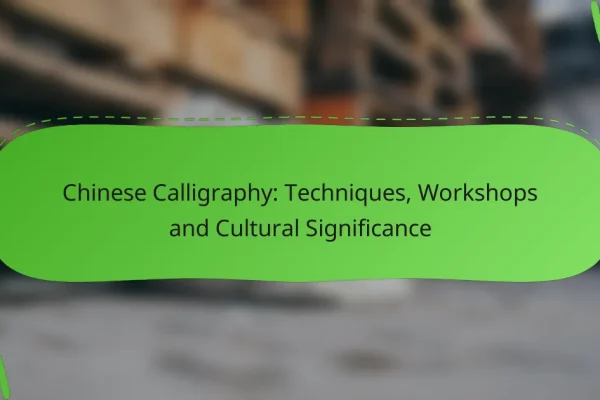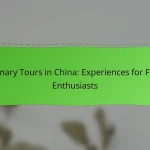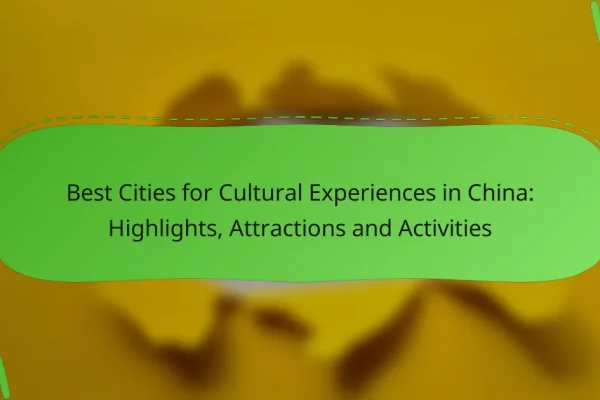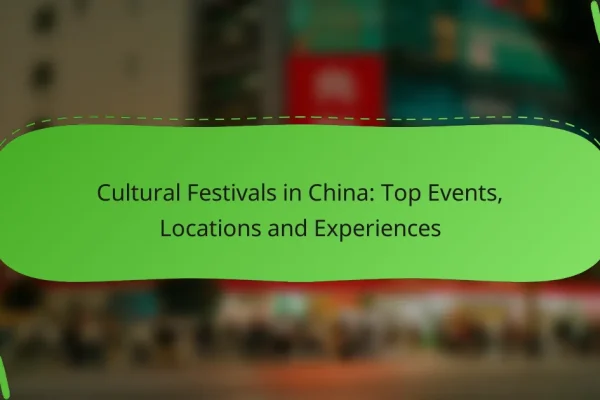What are the best cultural experiences in China?
The best cultural experiences in China include exploring historical landmarks, engaging in traditional practices, and tasting regional cuisines. These activities provide deep insights into China’s rich heritage and diverse customs.
Exploring the Great Wall of China
The Great Wall of China is one of the most iconic symbols of the country, stretching over 13,000 miles. Visitors can explore various sections, such as Badaling and Mutianyu, which are well-preserved and accessible. Each section offers unique views and experiences, from hiking to cable car rides.
When visiting, consider going early in the morning or late in the afternoon to avoid crowds. Wear comfortable shoes and bring water, as some areas involve steep climbs. Guided tours are available and can enhance your understanding of the wall’s history and significance.
Experiencing traditional Chinese tea ceremonies
Participating in a traditional Chinese tea ceremony offers a unique glimpse into the country’s tea culture. This ritual emphasizes the appreciation of tea’s flavor and aroma, often featuring various types of tea such as green, oolong, and pu-erh. Many tea houses in cities like Beijing and Hangzhou offer ceremonies for visitors.
During the ceremony, you will learn about the history of tea, the proper brewing techniques, and the etiquette involved. It’s a serene experience that encourages mindfulness and connection with the art of tea. Be prepared to taste multiple varieties and discover the nuances of each type.
Visiting the Terracotta Army in Xi’an
The Terracotta Army, located near Xi’an, is a remarkable archaeological site featuring thousands of life-sized statues of soldiers, horses, and chariots. Discovered in 1974, this UNESCO World Heritage site dates back to the 3rd century BC and was created to accompany China’s first emperor in the afterlife.
Visitors can explore the three main pits where the army is housed, each showcasing different aspects of this incredible find. Consider hiring a guide to gain deeper insights into the history and significance of the site. The nearby museum also provides context and displays additional artifacts from the era.
Participating in a Sichuan cooking class
A Sichuan cooking class is an excellent way to immerse yourself in one of China’s most famous culinary traditions. Known for its bold flavors and spicy dishes, Sichuan cuisine often features ingredients like chili peppers and Sichuan peppercorns. Classes typically include hands-on instruction in preparing dishes such as mapo tofu and kung pao chicken.
Look for classes that offer market tours, where you can learn about selecting fresh ingredients before cooking. Many classes are available in cities like Chengdu, and they cater to various skill levels. This experience not only teaches cooking techniques but also provides insight into the cultural significance of food in Sichuan.
How to plan a cultural trip to China?
Planning a cultural trip to China involves understanding local customs, choosing the right time to visit, and selecting key cultural hotspots. These steps ensure a meaningful experience that respects traditions and enhances your understanding of Chinese heritage.
Research local customs and etiquette
Understanding local customs and etiquette is crucial for a respectful and enjoyable visit. For example, greeting someone with a handshake is common, but a slight bow is also appreciated in more formal settings. Familiarize yourself with dining etiquette, such as using chopsticks properly and not sticking them upright in rice, as this resembles funeral rites.
Additionally, learning a few basic phrases in Mandarin can go a long way in showing respect and willingness to engage with the culture. Simple greetings like “Nǐ hǎo” (Hello) or “Xièxiè” (Thank you) can enhance interactions with locals.
Choose the right time to visit
The best time to visit China for cultural experiences generally falls during spring (April to June) and autumn (September to November). During these months, the weather is mild, making it comfortable for outdoor activities and sightseeing.
Avoiding major holidays, such as the Chinese New Year and National Day (October 1), can help you dodge large crowds and inflated prices. If you do visit during these times, plan accommodations and transportation well in advance.
Select cultural hotspots to explore
China is rich in cultural hotspots, each offering unique experiences. The Forbidden City in Beijing provides insight into imperial history, while the Terracotta Army in Xi’an showcases ancient artistry. Other notable locations include the Great Wall, the ancient water towns of Suzhou, and the vibrant markets of Chengdu.
Consider joining guided tours or cultural workshops, such as calligraphy or tea ceremonies, to deepen your understanding. Make a list of must-see sites and allocate sufficient time for each to fully appreciate their significance.
What are the unique cultural festivals in China?
China hosts a variety of unique cultural festivals that showcase its rich traditions and heritage. These festivals often involve vibrant celebrations, traditional performances, and communal activities that reflect the values and history of Chinese society.
Chinese New Year celebrations
Chinese New Year, also known as Spring Festival, is the most significant festival in China, marking the beginning of the lunar new year. Celebrations typically last for 15 days and include family reunions, feasting, and various cultural activities such as lion dances and fireworks.
During this time, people clean their homes to sweep away bad luck and decorate with red lanterns and couplets. Traditional foods like dumplings and fish symbolize prosperity and good fortune. It is common for families to exchange red envelopes containing money as a gesture of good luck.
Mid-Autumn Festival traditions
The Mid-Autumn Festival, celebrated on the 15th day of the eighth lunar month, honors the harvest and the full moon. Families gather to enjoy mooncakes, a traditional pastry filled with various fillings, and to admire the moon’s beauty.
Activities often include lantern displays and poetry recitals, emphasizing themes of reunion and gratitude. In some regions, people also perform dragon dances and set off fireworks, creating a festive atmosphere that brings communities together.
Harbin Ice Festival attractions
The Harbin Ice Festival, held annually in Harbin, Heilongjiang Province, is one of the world’s largest ice and snow festivals. It typically runs from early January to late February and features impressive ice sculptures, ice slides, and illuminated displays that attract visitors from around the globe.
Visitors can explore massive ice castles and participate in winter sports activities like ice skating and sledding. The festival highlights the creativity and craftsmanship of ice artists, with sculptures often reaching several meters in height, showcasing intricate designs and vibrant colors illuminated at night.
What are the top cities for cultural experiences in China?
The top cities for cultural experiences in China include Beijing, Shanghai, and Guilin, each offering unique insights into the country’s rich heritage. Visitors can explore historical landmarks, experience a blend of modern and traditional cultures, and enjoy stunning natural landscapes intertwined with cultural significance.
Beijing’s historical landmarks
Beijing is home to numerous historical landmarks that showcase China’s imperial past. The Forbidden City, a UNESCO World Heritage site, offers an extensive glimpse into the lives of emperors, while the Great Wall provides breathtaking views and a sense of ancient engineering prowess.
When visiting these sites, consider purchasing tickets in advance to avoid long lines, especially during peak tourist seasons. Guided tours can enhance your experience by providing context and stories behind these iconic locations.
Shanghai’s blend of modern and traditional
Shanghai presents a fascinating juxtaposition of modern skyscrapers and traditional neighborhoods. The Bund, with its colonial architecture, contrasts sharply with the futuristic skyline of Pudong, making it a must-see for any traveler.
To truly appreciate Shanghai’s culture, explore the Yu Garden, which reflects classical Chinese garden design. Additionally, sampling local cuisine in traditional teahouses can provide a deeper understanding of the city’s culinary heritage.
Guilin’s natural beauty and cultural heritage
Guilin is renowned for its stunning karst landscapes and rich cultural heritage. The Li River cruise is a popular way to experience the region’s breathtaking scenery, with limestone peaks and lush greenery lining the waterway.
In addition to its natural beauty, Guilin offers opportunities to engage with local ethnic minorities, such as the Zhuang and Yao people. Participating in cultural festivals or visiting local markets can provide authentic insights into their traditions and lifestyles.
How to choose cultural tours in China?
Choosing cultural tours in China requires careful consideration of your interests, budget, and the authenticity of the experiences offered. Look for tours that provide a deep dive into local traditions, cuisine, and history, ensuring a memorable and enriching experience.
Evaluate tour guides and their expertise
Assessing the expertise of tour guides is crucial for an enriching cultural experience in China. Look for guides who are fluent in your language and have extensive knowledge of local customs, history, and geography.
Check reviews and ratings on travel platforms to gauge the quality of their services. Experienced guides often have certifications or affiliations with reputable tour organizations, which can further assure their credibility.
Consider asking potential guides about their specific experiences and areas of focus. For instance, a guide specializing in Chinese art may offer unique insights into local galleries, while one with a background in history can provide context to ancient sites.










